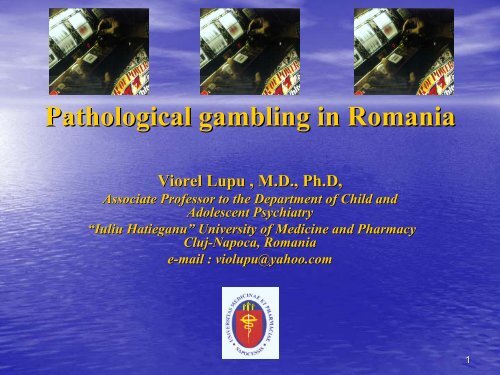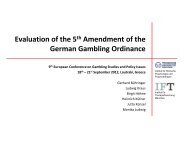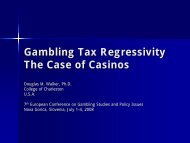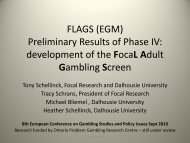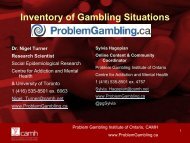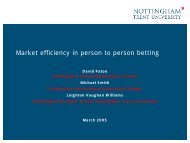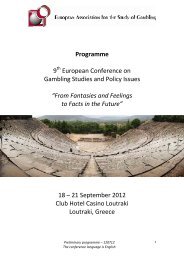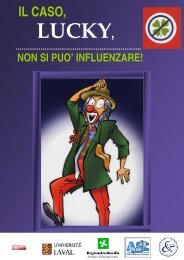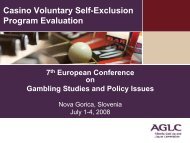Pathological gambling in Romania - European Association for the ...
Pathological gambling in Romania - European Association for the ...
Pathological gambling in Romania - European Association for the ...
Create successful ePaper yourself
Turn your PDF publications into a flip-book with our unique Google optimized e-Paper software.
<strong>Pathological</strong> <strong>gambl<strong>in</strong>g</strong> <strong>in</strong> <strong>Romania</strong>Viorel Lupu , M.D., Ph.D,Associate Professor to <strong>the</strong> Department of Child andAdolescent Psychiatry“IuliuHatieganu” University of Medic<strong>in</strong>e and PharmacyCluj-Napoca, <strong>Romania</strong>e-mail : violupu@yahoo.com.1
CLUJ-NAPOCANAPOCA-ROMANIA (EU)2
Introduction• The events <strong>in</strong> 1989 led to a different degree offreedom <strong>for</strong> <strong>Romania</strong>n people that was alsoreflected <strong>in</strong> an <strong>in</strong>crease <strong>in</strong> <strong>the</strong> offer of <strong>gambl<strong>in</strong>g</strong>games.• <strong>Romania</strong> has a top position as far as <strong>the</strong> no. ofplaces to gamble/no. of people ratio is concerned• The pyramidal games and <strong>the</strong> televised b<strong>in</strong>gogames showed <strong>the</strong>ir impact on millions of<strong>Romania</strong>ns, lead<strong>in</strong>g to <strong>the</strong>ir impoverishment3
Introduction• In 2000, <strong>gambl<strong>in</strong>g</strong> was seen by most <strong>Romania</strong>nsas <strong>the</strong> only chance to significantly improve<strong>the</strong>ir liv<strong>in</strong>g standard. (Insomar(polls, 1,241people).• 63% of <strong>Romania</strong>ns admitted to hav<strong>in</strong>ggambled or hav<strong>in</strong>g won <strong>in</strong> such chance games.• 23% of <strong>the</strong> ones who hadn’t t gambled reportedthat <strong>the</strong>y wanted to do so <strong>in</strong> <strong>the</strong> future.4
Postcomunist perspectives about<strong>gambl<strong>in</strong>g</strong> <strong>in</strong> <strong>Romania</strong>Next to <strong>the</strong> classical cas<strong>in</strong>os <strong>the</strong>re areapproximately 900 firms that already ownauthorized <strong>gambl<strong>in</strong>g</strong> devices, some of <strong>the</strong>sefirms develop<strong>in</strong>g real networks, thus greatlyenhanc<strong>in</strong>g <strong>the</strong> number of locations where<strong>gambl<strong>in</strong>g</strong> becomes possible.5
Postcomunist perspectives about<strong>gambl<strong>in</strong>g</strong>• There are approximately 36,000 <strong>gambl<strong>in</strong>g</strong> devices<strong>in</strong> <strong>the</strong> country, mean<strong>in</strong>g 1.5 devices <strong>for</strong> each 1000<strong>in</strong>habitants from classical electronic poker games<strong>in</strong> outskirt locations to <strong>the</strong> most sophisticated ones<strong>in</strong> luxury cas<strong>in</strong>os.• In Bucharest only <strong>the</strong>re are 10 live cas<strong>in</strong>os and<strong>the</strong>re are ano<strong>the</strong>r 10 live cas<strong>in</strong>os <strong>in</strong> <strong>the</strong> largecities:IaIaşi, Cluj, Timişoara, Bacăucău,Constanţa.6
Table 1:Favorite <strong>gambl<strong>in</strong>g</strong> <strong>for</strong>ms <strong>in</strong> 20007
Gambl<strong>in</strong>g opportunities• In <strong>the</strong> last few months of 2006, , <strong>the</strong>re was amassive <strong>in</strong>crease <strong>in</strong> <strong>the</strong> number of locations where<strong>gambl<strong>in</strong>g</strong> was possible, especially <strong>in</strong> Bucharest.• The number of authorized licenses granted by <strong>the</strong>M<strong>in</strong>istry of F<strong>in</strong>ances reveals two massive <strong>in</strong>creases<strong>in</strong> <strong>the</strong> number of <strong>gambl<strong>in</strong>g</strong> devices. The first onewas at <strong>the</strong> beg<strong>in</strong>n<strong>in</strong>g of <strong>the</strong> 1990s and <strong>the</strong> secondone <strong>in</strong> <strong>the</strong> last two to three years.8
Gambl<strong>in</strong>g opportunities• In <strong>the</strong> last ten years, bett<strong>in</strong>g came <strong>in</strong>tovogue <strong>in</strong> <strong>Romania</strong>.• In 2006, , <strong>the</strong>re were 500 bett<strong>in</strong>g agencies <strong>in</strong><strong>Romania</strong> of which 100 were <strong>in</strong> Bucharest.Those who bet <strong>in</strong> 2006 won 12% more than<strong>in</strong> 2005, <strong>the</strong> w<strong>in</strong>n<strong>in</strong>g amount of moneyexceed<strong>in</strong>g over €100 million.9
Gambl<strong>in</strong>g opportunities• The highest amount <strong>in</strong> 2006 was of €765,000, , wonwith a comb<strong>in</strong>ed ticket <strong>in</strong>volv<strong>in</strong>g <strong>the</strong> <strong>European</strong>and national football championship.• In months without special events, <strong>Romania</strong>ns usedto bet approximately 4,000,000 tickets, , a numberthat is cont<strong>in</strong>ually grow<strong>in</strong>g.• Five years ago, among <strong>the</strong> 18- to 25-year olds, 1 <strong>in</strong>10 <strong>Romania</strong>ns gambled on sports-betsbets. . Thisnumber has risen sharply to 8 out of 10. . Thehighest chances of w<strong>in</strong>n<strong>in</strong>g are on <strong>the</strong> tickets onwhich three to five events are bet, with a mean of €1.76 per ticket.10
Gambl<strong>in</strong>g opportunities• People of all ages bet, regardless social class, with<strong>the</strong> amount of money bet vary<strong>in</strong>g between €1.5and €300.There are three types of bettors:• (i) those that go to <strong>the</strong> bett<strong>in</strong>g agency 2-323 times aweek and bet m<strong>in</strong>imal amounts of money (€0.5(0.5-1);(ii) those who bet on a s<strong>in</strong>gle event (e.g., footballmatch) relatively large amounts of money (€30);(and• (iii) those who bet <strong>for</strong> maximum prizes and play<strong>in</strong> a syndicate with 3-434 o<strong>the</strong>r <strong>in</strong>dividuals.11
Gambl<strong>in</strong>g opportunities• Ano<strong>the</strong>r notable trend isrepresented by games which takeplace on <strong>the</strong> <strong>in</strong>ternet (e.g.,www.partygam<strong>in</strong>g.com)12
Gambl<strong>in</strong>g <strong>in</strong> adults• At <strong>the</strong> moment, <strong>the</strong>re are no studies regard<strong>in</strong>g <strong>the</strong>prevalence of adult pathological <strong>gambl<strong>in</strong>g</strong> <strong>in</strong><strong>Romania</strong>. An <strong>in</strong>terview with one of <strong>the</strong> mostimportant staff members of a big cas<strong>in</strong>o <strong>in</strong>Bucharest has revealed that this phenomenon hasbecome an <strong>in</strong>creas<strong>in</strong>g problem <strong>in</strong> <strong>Romania</strong>.• This is despite <strong>the</strong> fact that <strong>the</strong>re are only 10cas<strong>in</strong>os <strong>in</strong> Bucharest. . Besides <strong>the</strong>se, <strong>the</strong>re areo<strong>the</strong>r 10 cas<strong>in</strong>os <strong>in</strong> <strong>the</strong> large cities Cluj, Timişoaraoara,Iaşi, Bacău, , and Constanţa. Each cas<strong>in</strong>o houses anaverage of ten gam<strong>in</strong>g tables.13
Gambl<strong>in</strong>g <strong>in</strong> adults• Roulette is <strong>the</strong> most frequently attended game <strong>in</strong><strong>Romania</strong>n cas<strong>in</strong>os. . The average number of clientsattend<strong>in</strong>g a cas<strong>in</strong>o<strong>in</strong><strong>Romania</strong> isofapproximately 270, depend<strong>in</strong>g on <strong>the</strong> day of <strong>the</strong>week, weekends correspond<strong>in</strong>g to <strong>the</strong> highestfrequency. From <strong>the</strong> adult clients of <strong>the</strong> cas<strong>in</strong>os,<strong>the</strong> majority is middle aged, <strong>in</strong>clud<strong>in</strong>g women aswell. Clients belong to all social categories.14
Gambl<strong>in</strong>g <strong>in</strong> adults• The pyramidal game called “Caritas” becamehugely popular <strong>in</strong> <strong>Romania</strong> between 1991 and1993. The number of <strong>in</strong>dividuals participat<strong>in</strong>g <strong>in</strong><strong>the</strong> game was over 250,000, , and who depositedlarge amounts of money at <strong>the</strong> “Caritas” agencieswith its centre <strong>in</strong> Cluj-Napoca, hop<strong>in</strong>g that <strong>the</strong>deposited amount would multiply by 7 to 8 times.• The game made over €38,000,000<strong>in</strong> a two-yearperiod. Based on this phenomenon, a devaluationof <strong>the</strong> notion of money and a disjunction of <strong>the</strong>connection between earn<strong>in</strong>g money and honestwork<strong>in</strong>g has appeared.15
Gambl<strong>in</strong>g <strong>in</strong> adults• A considerable number of participants are los<strong>in</strong>glarge amounts of money <strong>in</strong> this way withoutsufficient deliberation. The tendency to <strong>in</strong>crease<strong>the</strong> stake at registration also exists, with playersfalsely believ<strong>in</strong>g that this may lead to prolong<strong>in</strong>g<strong>the</strong> participation at <strong>the</strong> game, thus controll<strong>in</strong>gprofit. This was one of <strong>the</strong> ways <strong>in</strong> which <strong>the</strong> largeexpansion of <strong>gambl<strong>in</strong>g</strong> happened both at <strong>the</strong> socialand <strong>in</strong>dividual level.16
Gambl<strong>in</strong>g <strong>in</strong> adults• F<strong>in</strong>ally, <strong>the</strong> entire <strong>gambl<strong>in</strong>g</strong> bus<strong>in</strong>ess proved to bea huge f<strong>in</strong>ancial sw<strong>in</strong>dle, <strong>the</strong> ‘game’ end<strong>in</strong>g <strong>in</strong>June 2003, , leav<strong>in</strong>g beh<strong>in</strong>d a large number ofvictims, while <strong>the</strong> executive of <strong>the</strong> agency IoanStoica was arrested on August 25 th1994, andreceiv<strong>in</strong>g a six-year prison sentence. Afterscamm<strong>in</strong>g hundreds of thousands of people allover <strong>the</strong> country, <strong>the</strong> legislative body ratified <strong>the</strong>law regard<strong>in</strong>g <strong>gambl<strong>in</strong>g</strong>, which regulates, <strong>for</strong>bids,and punishes <strong>the</strong> creation of f<strong>in</strong>ancial pyramids.17
(<strong>Pathological</strong>) <strong>gambl<strong>in</strong>g</strong>: Evidencewith regard to adolescentsLupu, Onaca and Lupu (2002) have carried out researchregard<strong>in</strong>g <strong>the</strong> prevalence of pathological <strong>gambl<strong>in</strong>g</strong> <strong>in</strong><strong>Romania</strong> on 500 high-school students <strong>in</strong> three counties(Cluj, Sălaj, , and Bacău),with ages between 14-19 19 years,56.6% be<strong>in</strong>g girls (n=283) and 43.4% be<strong>in</strong>g boys (n=217).An anonymous questionnaire <strong>in</strong>cluded a standardizedscale called “20 Questions of Gamblers Anonymous” andano<strong>the</strong>r 20 questions about age, gender, family, <strong>in</strong>come,school, drug abuse, <strong>gambl<strong>in</strong>g</strong> preferences, <strong>the</strong> frequencyand <strong>the</strong> amount of money <strong>the</strong>y use <strong>in</strong> <strong>gambl<strong>in</strong>g</strong>, etc.18
Results• 6.8% of <strong>the</strong> subjects could be diagnosedwith pathological <strong>gambl<strong>in</strong>g</strong>, with a sexratio of 4.66M/1F .• The mean age <strong>in</strong> start<strong>in</strong>g <strong>gambl<strong>in</strong>g</strong> that<strong>the</strong> study revealed was 13.25±1.51 1.51 years.• 82.35% gambled <strong>in</strong> groups, while 17.64%were <strong>in</strong>dividual gamblers .19
Results• 47.05% were highly frequent gamblers (almost daily),and 38.23% were frequent gamblers (at least once aweek).• The <strong>gambl<strong>in</strong>g</strong> games that were chosen at <strong>the</strong> highestfrequency were: pool (55.88%), poker (35.29%), b<strong>in</strong>go(32.35%), basketball on a bet (5.88%), black-jack androulette.• The maximum sums gambled that <strong>the</strong> study revealed:USD 0.5-5 5 (32.35%); USD 5-105(32.35%); USD 10-100100(20.58%), and USD 100-1000 1000 (14.70%), <strong>the</strong> meansalary <strong>in</strong> <strong>Romania</strong> be<strong>in</strong>g around USD 80/ month at <strong>the</strong>time .20
Results• 41.17% belonged to families with low <strong>in</strong>comes, while58.83% belonged to families with high and very high<strong>in</strong>comes.• 64.70% were identified with absenteeism because of<strong>gambl<strong>in</strong>g</strong>; 52.94% showed modest results at school.• 76.47% of <strong>the</strong> <strong>gambl<strong>in</strong>g</strong> subjects believed <strong>the</strong>y couldcontrol <strong>the</strong> game; 26.47% stated that, <strong>in</strong> <strong>the</strong>ir vision,chance had no <strong>in</strong>fluence on <strong>the</strong> ga<strong>in</strong>.21
Discussion of results• The results <strong>in</strong>dicate a clear prevalence of pathological<strong>gambl<strong>in</strong>g</strong> <strong>in</strong> males, with a sex ratio of at least 4.66M/1F.This f<strong>in</strong>d<strong>in</strong>g is <strong>in</strong> agreement with <strong>the</strong> data <strong>in</strong> DSM-IV(1994), which po<strong>in</strong>ts out <strong>the</strong> fact that only 1/3 of <strong>the</strong>gamblers are females.• The disorder starts more frequently earlier <strong>in</strong> malesand later <strong>in</strong> females.• The 6.8% prevalence of pathological gamblers among<strong>Romania</strong>n teenagers is very close to that found byProimos (1998) <strong>in</strong> UK, of 6,0%.22
Discussion of results• The explanation of <strong>the</strong> high prevalence ofpathological <strong>gambl<strong>in</strong>g</strong> <strong>in</strong> <strong>Romania</strong>n teenagerscan be found <strong>in</strong> <strong>the</strong> desire to ga<strong>in</strong> money,teenagers associate with social status, with isseen as highly valuable <strong>in</strong> <strong>the</strong> context of <strong>the</strong>general impoverishment of <strong>the</strong> population.• The fact that <strong>the</strong> majority of teenagers(82.35%) practise group <strong>gambl<strong>in</strong>g</strong> is expla<strong>in</strong>edby <strong>the</strong> typical wish to be found at <strong>the</strong> age ofadolescence: <strong>in</strong>tegrat<strong>in</strong>g <strong>in</strong>to groups of<strong>in</strong>dividuals of <strong>the</strong> same age.23
Discussion of results• The study shows that an important part of <strong>the</strong><strong>gambl<strong>in</strong>g</strong> teenagers neglect school, which graduallyleads to <strong>the</strong>ir social dysadaptation.• An extremely high percentage of <strong>gambl<strong>in</strong>g</strong> subjects feltthat <strong>the</strong>y could control <strong>the</strong> game, which confirms <strong>the</strong>diagnosis. This fact was already observed by Langer <strong>in</strong>1975. He stated that gamblers develop an illusoryperception of <strong>the</strong> game control, facilitated by <strong>the</strong>contact with <strong>the</strong> game, <strong>the</strong> degree of competition and<strong>in</strong>volvement and <strong>the</strong> complexity of <strong>the</strong> game.24
Discussion of results• At present, <strong>the</strong> most popular <strong>gambl<strong>in</strong>g</strong> games are pool,poker and b<strong>in</strong>go.• Almost 15% of <strong>the</strong> teenagers gambled <strong>in</strong> one sessionsums that are higher than <strong>the</strong> value of <strong>the</strong> mean <strong>in</strong>come<strong>in</strong> our country. (Lupu(et al 2001a).• The gamblers belonged to both social environmentswith modest <strong>in</strong>comes and social environments with highand very high <strong>in</strong>comes <strong>in</strong> similar proportions. (Lupu(etal 2001b).25
Discussion of results• Buchta(1995) recommended <strong>the</strong> <strong>in</strong>clusion of thisdisorder <strong>in</strong> <strong>the</strong> prophylaxis programs of mental healthcenters <strong>for</strong> teenagers, upon f<strong>in</strong>d<strong>in</strong>g a high <strong>in</strong>cidence ofpathological <strong>gambl<strong>in</strong>g</strong> <strong>in</strong> American teenagers.• This could also be applied <strong>in</strong> <strong>Romania</strong>, consider<strong>in</strong>g <strong>the</strong>expansion and seriousness of <strong>the</strong> problem among<strong>Romania</strong>n teenagers.• We consider that this objective requires <strong>the</strong>implementation of a national program <strong>for</strong> <strong>the</strong>prophylaxis of <strong>the</strong> development of <strong>gambl<strong>in</strong>g</strong> addiction,similar to <strong>the</strong> present national program <strong>for</strong> <strong>the</strong>prevention of alcohol and drug use among youngpeople.26
Conclusions• 1) A high prevalence, 6.8%, of pathological <strong>gambl<strong>in</strong>g</strong>is found <strong>in</strong> <strong>Romania</strong>n teenagers;• 2) The majority of gamblers are males (82.35%) andpractise games <strong>in</strong> groups, preferr<strong>in</strong>g especially pool,poker and b<strong>in</strong>go.• 3) Approximately 2/5 of <strong>the</strong> gamblers gamble <strong>in</strong> as<strong>in</strong>gle game session sums of money equal to or higherthan <strong>the</strong> mean salary <strong>in</strong> <strong>Romania</strong>.27
Conclusions• 4) 3/4 of <strong>the</strong> teenagers believe that <strong>the</strong>y can control<strong>the</strong> game• 5) The majority of <strong>the</strong> teenagers also present schooldysadaptation, along with marked absenteeism andmodest results.• 6) We propose <strong>the</strong> <strong>in</strong>clusion of <strong>the</strong> problem ofpathological <strong>gambl<strong>in</strong>g</strong> <strong>in</strong> <strong>the</strong> prophylaxis programsof mental health centres from all over <strong>the</strong> country.28
(<strong>Pathological</strong>) <strong>gambl<strong>in</strong>g</strong>: Evidencewith regard to adolescents• Ano<strong>the</strong>r study (Lupu, Boroş, Miu, Iftene &Geru, , 2001) analyzed <strong>the</strong> risk factors <strong>for</strong>pathological <strong>gambl<strong>in</strong>g</strong> <strong>in</strong> <strong>Romania</strong>nadolescents who were high school andvocational-school children (n=231),withages between 14 and 18 years, <strong>in</strong> Cluj, , Satu-Mare, and Argeş counties.29
The most important risk factors <strong>for</strong>pathological <strong>gambl<strong>in</strong>g</strong> were:• divorce/<strong>the</strong> separation of parents;• a serious physical illness of one of <strong>the</strong> familymembers;• <strong>the</strong> death of a family member;• family break-up;• <strong>the</strong> psychological disorder of one of <strong>the</strong>family members, and• participation <strong>in</strong> a severe accident.30
(<strong>Pathological</strong>) <strong>gambl<strong>in</strong>g</strong>: Evidencewith regard to adolescents• In 14% of <strong>the</strong> pathological gamblers, co-morbidity with <strong>the</strong> use of illegal drugs wasalso revealed, while sexual abuse ofadolescents had also been identified as apotential risk factor <strong>for</strong> pathological<strong>gambl<strong>in</strong>g</strong>.31
Two profiles of adolescentpathological gamblers• 1) adolescents of 15-16 16 years of age, from anunfavorable family and social environment, whereshe/he has to deal with stressful, traumaticexperiences, such as neglect, physical, and/orsexual abuse. In <strong>the</strong>se cases, one may <strong>in</strong>terpretdependency on <strong>gambl<strong>in</strong>g</strong> as a cop<strong>in</strong>g mechanismof chronic stress;32
Profiles of adolescent pathologicalgamblers• 2) adolescents of 15-16 16 years of age, from afavorable family and social environmentwith a medium to high <strong>in</strong>come, where <strong>the</strong>most frequent reason <strong>for</strong> neglect<strong>in</strong>g <strong>the</strong>adolescent is <strong>the</strong> parents’ extremely busyschedule. In <strong>the</strong>se cases <strong>gambl<strong>in</strong>g</strong> may be away to spend time and/or to attract aparent’s s attention.33
(<strong>Pathological</strong>) <strong>gambl<strong>in</strong>g</strong>: Evidencewith regard to adolescents• As <strong>in</strong> <strong>the</strong> study conducted by Lupu et al. (2002), <strong>the</strong> “20Questions of Gamblers Anonymous” were used to assess<strong>gambl<strong>in</strong>g</strong>-related problems. However, <strong>the</strong> authors changed<strong>the</strong> scor<strong>in</strong>g of <strong>the</strong> items by <strong>in</strong>clud<strong>in</strong>g a category of sub-cl<strong>in</strong>ical diagnosis, which offered more <strong>in</strong><strong>for</strong>mation about<strong>the</strong> frequency and proportion of <strong>gambl<strong>in</strong>g</strong>. This led to <strong>the</strong>follow<strong>in</strong>g categories:a) non-<strong>gambl<strong>in</strong>g</strong>/recreational <strong>gambl<strong>in</strong>g</strong> and occasional<strong>gambl<strong>in</strong>g</strong> (0-1 1 positive answers = level 1);b) problem <strong>gambl<strong>in</strong>g</strong> (2-6 6 positive answers = level 2); andc) pathological <strong>gambl<strong>in</strong>g</strong> (7-20 positive answers = level 3).34
Risk factors <strong>for</strong> (<strong>Pathological</strong>)<strong>gambl<strong>in</strong>g</strong>• The data revealed that 34% of <strong>the</strong> participants do notgamble at all, or only gamble occasionally, 54%represented problem gamblers, , and 12% could beclassified as pathological gamblers.• Cluster analysis disclosed a group<strong>in</strong>g of risk factors <strong>for</strong><strong>gambl<strong>in</strong>g</strong> <strong>in</strong> three categories:• 1)personal risk factors(physical/psychological illness,severe accidents),• 2)family environment (physical abuse, neglect, education,separation of parents, number of sibl<strong>in</strong>gs), and• 3)stressful events (<strong>the</strong> break-up of a romantic relationship,social mobility, number of schools attended, familytraumas, sexual abuse).35
For problem gamblers, <strong>the</strong> mostimportant risk factors were :• change of residence (61%);• <strong>the</strong> existence of psychological (60%) orsevere physical disorders <strong>in</strong> one of <strong>the</strong>family members (59%);• <strong>the</strong> death of a family member (57%);• severe physical illness (55%), and• be<strong>in</strong>g an only-child(50%).36
Risk factors <strong>for</strong> pathologicalgamblers• witness<strong>in</strong>g severe accidents;• <strong>the</strong> psychological or somatic illness of a family member;• <strong>the</strong> break-up of a romantic relationship;• <strong>the</strong> death of a family member, and <strong>the</strong> divorce of <strong>the</strong>parents.• The number of pathological gamblers was significantlyhigher (29%) <strong>in</strong> those who suffered a severe accidentcompared to those who did not (10%).• Sexual abuse was twice as frequent <strong>in</strong> <strong>the</strong> case ofpathological gamblers compared to problem gamblers, andsignificantly more frequent when compared to non-gamblers.37
Risk factors <strong>for</strong> pathologicalgamblers• The analysis of a syn<strong>the</strong>tic <strong>in</strong>dex, whichadditionally comprises sexual abuse (stressfulevents), showed a significant difference <strong>in</strong> meanfrequencies between pathological gamblers andnon-gamblers.• The same significant difference was also found <strong>in</strong><strong>the</strong> case of ano<strong>the</strong>r syn<strong>the</strong>tic <strong>in</strong>dex (unfavorablefamily environment), with frequencies between 5.8(<strong>in</strong> <strong>the</strong> case of non-gamblers) to 7.3 (<strong>for</strong>pathological gamblers).38
Risk factors <strong>for</strong> pathologicalgamblers• The third syn<strong>the</strong>tic <strong>in</strong>dex circumscribespersonal risk factors and registered adifference <strong>in</strong> <strong>the</strong> same direction (non-gamblers vs. pathological gamblers).• The analysis of <strong>the</strong> data (see Table 2) showssignificant differences between non-gamblers and pathological gamblers.39
Risk factors <strong>for</strong> pathologicalgamblers• The most important consequences of pathological<strong>gambl<strong>in</strong>g</strong> appear to relate to <strong>the</strong> deterioration of<strong>the</strong> parent-child relationship. The pathologicalgamblers had a significantly higher number ofarguments with parents because of <strong>gambl<strong>in</strong>g</strong>(parents usually <strong>for</strong>bade <strong>gambl<strong>in</strong>g</strong>).• <strong>Pathological</strong> <strong>gambl<strong>in</strong>g</strong> strongly correlated with <strong>the</strong>number of school absences, a fact underscored by<strong>the</strong> significantly higher number of pathologicalgamblers (25%) whom <strong>the</strong> grade <strong>for</strong> conduct waslower, compared to non-players (3%).41
National politics to approach pathological<strong>gambl<strong>in</strong>g</strong>• At present <strong>in</strong> <strong>Romania</strong>, <strong>the</strong>re is no coherentstrategy regard<strong>in</strong>g <strong>the</strong> prevention andtreatment of pathological <strong>gambl<strong>in</strong>g</strong>. This isdespite <strong>the</strong> fact that <strong>the</strong> disorder isrecognized by <strong>the</strong> <strong>Romania</strong>n specialists,be<strong>in</strong>g diagnosed, coded and reportedaccord<strong>in</strong>g <strong>the</strong> WHO-ICDICD-10 classification,both at <strong>the</strong> level of psychiatric hospitals,ambulatories, and private offices.42
National politics to approach pathological<strong>gambl<strong>in</strong>g</strong>• Tak<strong>in</strong>g <strong>in</strong>to consideration <strong>the</strong> fact that <strong>the</strong>re is anempirical correlation between drug/alcoholaddictions and pathological <strong>gambl<strong>in</strong>g</strong> <strong>in</strong> <strong>Romania</strong>,<strong>the</strong> <strong>in</strong>clusion of <strong>gambl<strong>in</strong>g</strong> <strong>in</strong>to <strong>the</strong> actionsundertaken by National Anti-Drug <strong>Association</strong>(NAA)is extremely welcome, particularly aspathological <strong>gambl<strong>in</strong>g</strong> can be seen as a <strong>for</strong>m ofnon-pharmacological dependency. The proposal ofits <strong>in</strong>clusion was presented by Lupu, Boroş, Miu,Iftene and Geru (2001).43
The treatment methods currently available <strong>in</strong><strong>Romania</strong> used <strong>for</strong> pathological <strong>gambl<strong>in</strong>g</strong><strong>in</strong>clude:• 1. Selective seroton<strong>in</strong> reuptake <strong>in</strong>hibitors(Fluvoxam<strong>in</strong>e, Clomipram<strong>in</strong>e, , Prozac);• 2. Mood stabilizers (Carbamazep<strong>in</strong>e(Carbamazep<strong>in</strong>e);• 3. Individual and group cognitive and behavioral<strong>the</strong>rapies (<strong>in</strong>clud<strong>in</strong>g rational emotive andbehavioral <strong>the</strong>rapy);• 4.Counsel<strong>in</strong>g <strong>the</strong> gambler’s s family;• 5.Family <strong>the</strong>rapy;• 6.Psychological counsel<strong>in</strong>g.44
Treatments• These <strong>for</strong>ms of <strong>the</strong>rapy are available both<strong>for</strong> <strong>in</strong>patients and outpatients. The vastmajority of patients prefer to be treated asoutpatients <strong>in</strong> private offices. Un<strong>for</strong>tunately,<strong>in</strong> <strong>Romania</strong>, self-help groups (such asGamblers Anonymous) do not exist yet.45
Prevention• Tak<strong>in</strong>g <strong>in</strong>to consideration <strong>the</strong> fact that <strong>the</strong>etiology of pathological <strong>gambl<strong>in</strong>g</strong> is multi-factorial, <strong>in</strong>clud<strong>in</strong>g family/genetic,sociological, and <strong>in</strong>dividual factors, all <strong>the</strong>seelements have to be attentively analyzed <strong>in</strong>order to conceive an efficient primaryprevention, as well as a secondary andtertiary program <strong>in</strong> order to controlpathological <strong>gambl<strong>in</strong>g</strong> <strong>in</strong> <strong>Romania</strong>.46
Prevention• Promis<strong>in</strong>g examples of such attempts are <strong>the</strong>broadcast<strong>in</strong>g“Renaşterea”(“Rebirth”)from2001, , and an <strong>in</strong>teractive live television programorganized by Lupu <strong>in</strong> 2002, at <strong>the</strong> “TeleEuropaNova”, and <strong>in</strong> 2007 at “NCN TV”on<strong>the</strong> issue ofpathological <strong>gambl<strong>in</strong>g</strong>.• These programs have had a huge impact on <strong>the</strong>public <strong>in</strong> Cluj-NapocaNapoca.• A large number of <strong>in</strong>dividuals, family members ofpathological gamblers called on air, wish<strong>in</strong>g tof<strong>in</strong>d out more about <strong>the</strong> possible <strong>for</strong>ms oftreatment <strong>in</strong> <strong>the</strong>se disorders.47
Prevention• Consequently, <strong>the</strong> access to treatment hasgrown drastically, pathological gamblersbe<strong>in</strong>g brought to specialized private officesby family members. This is an extremelyimportant aspect, s<strong>in</strong>ce pathological<strong>gambl<strong>in</strong>g</strong> is an ego-syntonicdisorder, whichleads to a low direct access to <strong>the</strong>rapy.48
CONCLUSIONS• Tak<strong>in</strong>g <strong>in</strong>to consideration <strong>the</strong> fact that <strong>the</strong>number of adolescents and young adultswho gamble has been dramatically<strong>in</strong>creas<strong>in</strong>g <strong>in</strong> <strong>Romania</strong>, urgent regulation atnational level of this issue has become amajor issue.49
CONCLUSIONS• These observations should <strong>in</strong>itiate <strong>the</strong> beg<strong>in</strong>n<strong>in</strong>g ofcomprehensive empirical research <strong>in</strong> order toreveal <strong>the</strong> prevalence of <strong>gambl<strong>in</strong>g</strong> <strong>in</strong> adults and<strong>the</strong> monitor<strong>in</strong>g of such tendencies <strong>in</strong> adolescents.These needs become more and more str<strong>in</strong>gentespecially because of <strong>the</strong> ‘explosion’ <strong>in</strong> <strong>the</strong> numberof locations where <strong>gambl<strong>in</strong>g</strong> has become possible<strong>in</strong> <strong>the</strong> last two to three years <strong>in</strong> <strong>Romania</strong>.50
CONCLUSIONS• For this <strong>in</strong>tervention to be efficient, onemust obta<strong>in</strong> adequate f<strong>in</strong>anc<strong>in</strong>g, whichmight come from <strong>the</strong> taxes paid by <strong>the</strong><strong>gambl<strong>in</strong>g</strong> <strong>in</strong>dustry <strong>in</strong> <strong>Romania</strong>.Besides sensitiz<strong>in</strong>g <strong>the</strong> population,<strong>in</strong>tervention has to be closely <strong>in</strong>tegratedwith <strong>the</strong> legislation and specialists <strong>in</strong> <strong>the</strong>doma<strong>in</strong> of mental health.51
CONCLUSIONSThus, <strong>the</strong> <strong>Romania</strong>n population may f<strong>in</strong>dout when, where, and how one may ask <strong>the</strong>help of a professional <strong>in</strong> this regard, <strong>in</strong>order to get treatment.52
CONCLUSIONS• Never<strong>the</strong>less, <strong>the</strong> urgent sett<strong>in</strong>g up of supportgroups such as Gamblers Anonymous is essential.In this way, <strong>Romania</strong>n patients will benefit fromall types of <strong>in</strong>tervention available <strong>in</strong> Europe andaround <strong>the</strong> world.• Empirically validated <strong>for</strong>ms of <strong>in</strong>terventionshould be implemented, as soon as possible,target<strong>in</strong>g primary, secondary, and tertiaryprevention of pathological <strong>gambl<strong>in</strong>g</strong> <strong>in</strong> <strong>Romania</strong>.53
THANK YOU FOR YOURATTENTION!54


